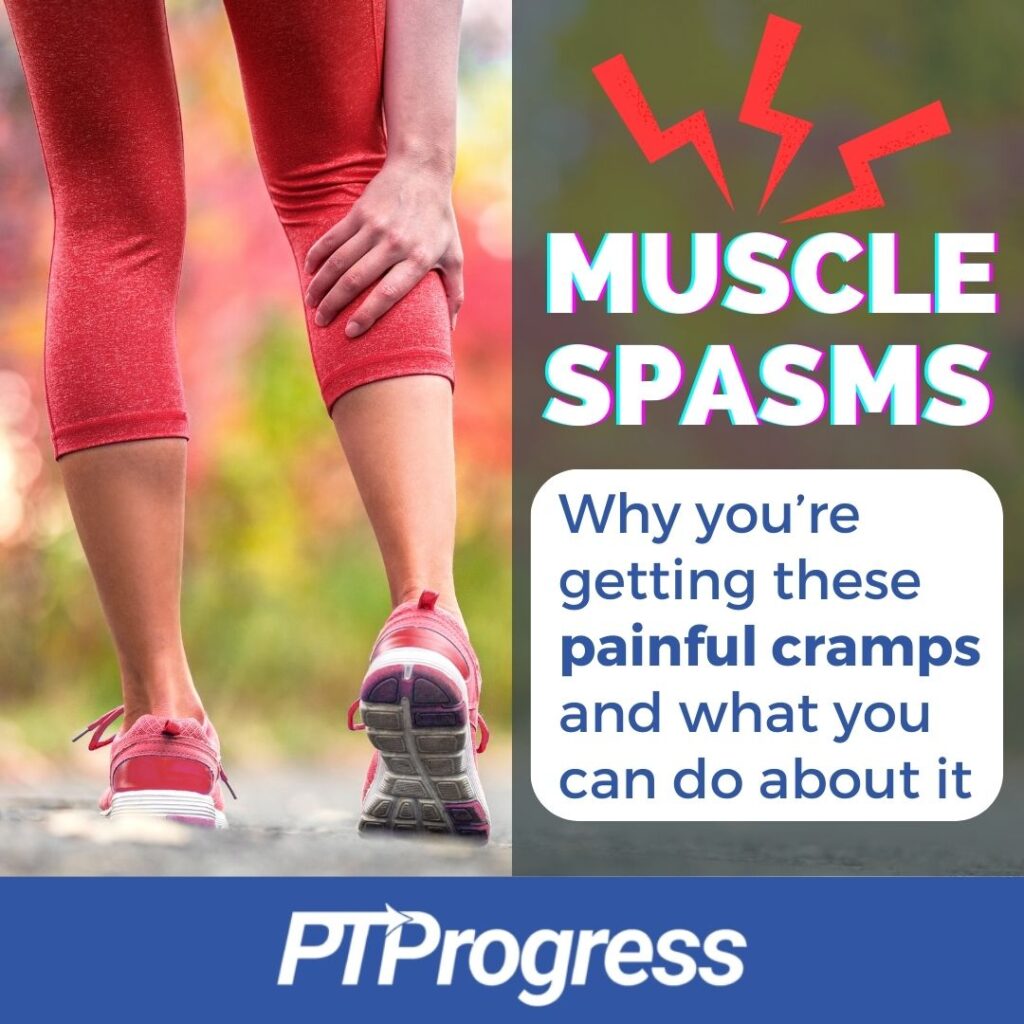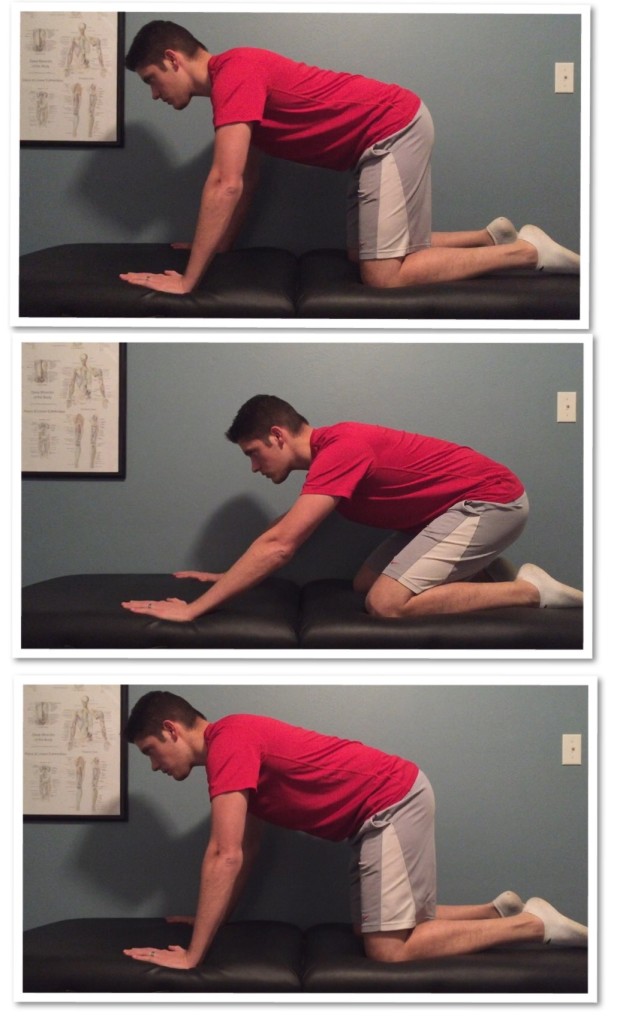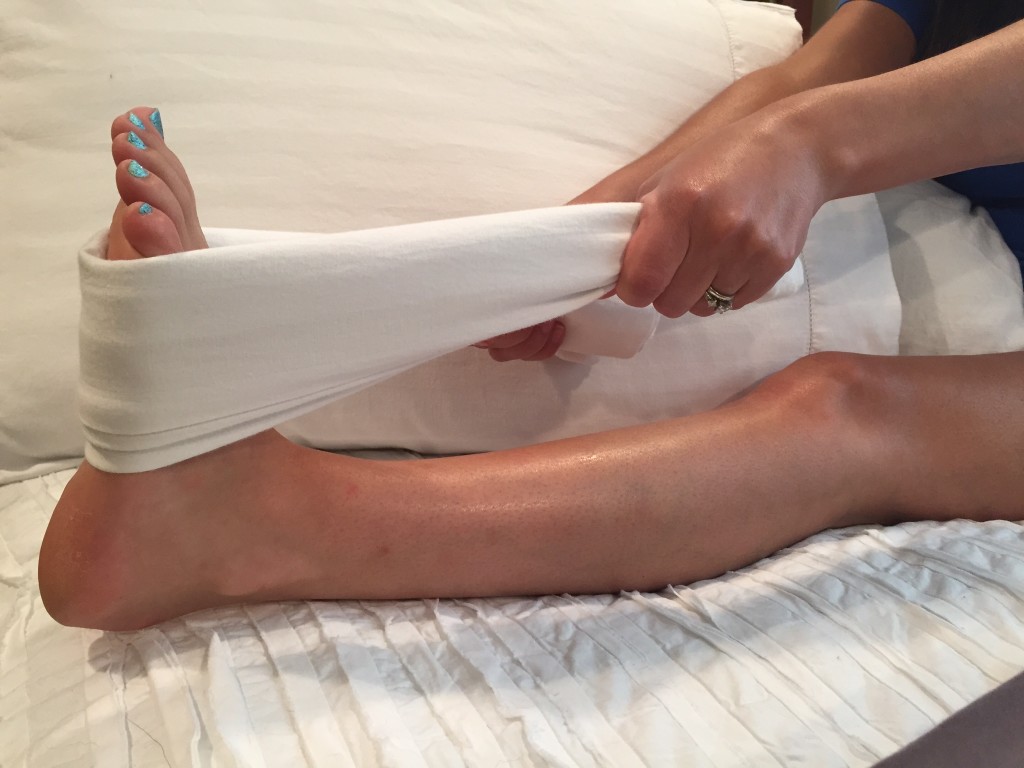
Have you ever gone for a run only to be hit with a “side-stitch” cramp? Or felt the bottom of your feet seize up while swimming? If you’re really unlucky, you’ve awoken in the middle of the night to a painful “charley horse” in your leg. All these experiences involve muscle spasms, and in this article I’ll explain why your muscles may be cramping and what you can do to alleviate the spasm.
What Are Muscle Spasms?
Muscle spasms are painful contractions or cramps in the muscles. Your muscles may twitch or convulse under the spasm, or become stiff and locked in place. When spasming, it may be difficult or painful to stretch the muscle, impeding your range of motion for a time. After the spasm your muscles may feel tender and sore.
Although it can happen anywhere, muscle spasms most often occur in the following body regions:
- Legs, especially the calf muscles
- Back
- Abdomen, especially around the ribcage
- Neck
- Arms
What Causes Muscle Spasms?

You may be more likely to experience muscle spasms if you are obese, over age 65, or pregnant. But there are many other factors that can make your muscle spasms more or less prevalent.
Dehydration
One of the most common causes of muscle spasms is dehydration from sweating. Dehydration depletes your body of naturally-occuring chemicals such as potassium, magnesium, and calcium, called electrolytes. Your muscles rely on these electrolytes to contract, rehydrate, and recover.
But your muscles can become deficient in electrolytes for reasons other than not drinking enough water. Medications, such as diuretics and statins, can deplete your fluids without all the sweating you may expect from being dehydrated.
Vomiting or diarrhea can similarly dehydrate you and make you susceptible to a muscle spasm. Laxatives, too, can flush your body of fluids and cause an imbalance in your electrolytes, leading to more frequent muscle spasms.
Too Much Exercise—Or Not Enough
Muscle cramps often occur while working out, such as in the opening examples of running and swimming. If you’re out of shape, don’t exercise regularly, or insufficiently warm up before a workout, you may be setting yourself up for a cramp.
Conversely, over-exercising can cause a muscle cramp. Athletes are especially susceptible to muscle spasms because of the strain they put on their bodies while training. If you develop a muscle spasm while exercising in intense heat, you may have “heat cramps,” a sign of heat exhaustion.
But you can experience muscle spasms while at rest. Sitting in one position for too long, such as for a long-haul flight, can cause excessive stiffness and cramping in your legs from a lack of blood circulation. If you have a sedentary job, consider getting up and walking around every 30 minutes or so to stave off stiffness and spasms.
Other Factors
If unrelated to your hydration or activity, your muscle spasms might be the result of stress, insufficient sleep, or excess caffeine. In some cases, muscle spasms can indicate a more serious medical concern such as kidney disease or certain nerve conditions such as dystonia, ALS, Isaacs’ syndrome, and neuropathy.
How to Treat Muscle Spasms
With these causes in mind, there are some simple steps you can take to prevent a painful muscle spasm. But keep in mind that in some cases, you may just have to wait it out; some muscle spasms need time to fully relax.

Drink Water
Because muscle spasms are so often caused by dehydration, one of the first things you should do is drink water. If you suspect a lack of electrolytes, reach for a glass of milk or a banana with your water.
Stretch
Because your muscles are contracting when under a spasm, stretching can help the muscle lengthen and recover. Begin first by mobilizing the area; for example, if you have a muscle spasm in your neck, introduce some motion by shrugging your shoulders slowly, up and down, and in a circular motion. Then focus on stretching any tight muscles by following some of these neck stretches. If your muscle cramp has balled up into a knot, work on massaging the trigger point before you stretch the muscle.
Stretching before bed can help prevent cramps at night. You may even opt for a light stroll around the block or an easy ride on your rowing machine to improve blood circulation and stave off a nighttime spasm. Just don’t work hard enough to bring your heartrate up, which could interfere with falling asleep.

Exercise
It may feel counter-intuitive, but continuing some form of exercise during a muscle spasm can help the cramps go away faster than if you only rest. For example, if you get side-stitch while running, don’t sit and call it quits. Slow your pace, take a minute to stretch your abdominals, then continue at a brisk walking pace until the cramps subside. Your continued exercise will help keep blood flowing to the cramped muscles and can prevent a recurrence.
In general, exercising regularly is a great way to prevent muscle spasms. If you get muscle cramps often, consider starting an exercise routine, such as a walking program followed by regular stretching and strengthening of the muscles. Just be careful not to strain your muscles as you exercise. Avoid excessive exercise targeting any one specific muscle group. Instead, focus on full-body workouts with a gradual progression of resistance.
Relaxation Techniques

If your muscle spasms are a result of stress, one of the best ways to prevent spasms is to try to relax, both physically and mentally. A massage therapist will use hands-on treatment to encourage the knotted tissue in your muscles to relax and lengthen. You may find a therapist who can also provide guided meditation to help your mind relax along with your body.
Other relaxation techniques can be performed at home on your own. These include breathing exercises such as the 4-7-8 method, practicing tai chi or yoga, and progressive muscle relaxation, which involves consciously contracting then relaxing each muscle group.
Other Helps
For immediate relief of an acute muscle spasm, you can take an over-the-counter painkiller like ibuprofen. A heat pad over the balled-up muscle can help melt away tough muscle tension and find you relief. Conversely, you can apply an ice pack to your spasm for up to 20 minutes to help block the pain that’s locking up your muscle.
If your cramps persist, become unbearable or spread all over your body, seek medical attention.
How to Treat Muscle Spasms in the Back
Muscle spasms in the low back are often caused by improper lifting. With the right amount of rest, stretching, and careful activity, you can help a mild back spasm evaporate into memory.
Quadruped Rock Back

Get on your hands and knees, with your back in a neutral position. From here, slowly rock back your bottom towards your feet, only going as far as is comfortable. Rock back to the starting position and repeat, increasing your range of motion as is comfortable. Repeat this exercise 5–6 times throughout the day.
Walking
Walking helps encourage blood circulation throughout your body, including the tight muscles in your back. It’s easy to scale, so modify your pace and distance based on your level of pain. Make sure you keep your back relaxed while walking; holding tension in your back will only make your spasms worse and more frequent.
Avoid hills until your back feels better, and stick to shorter, more frequent walks (say, 5–10 minutes, 3–4 times a day) in the days immediately following your spasm.
Abdominal Bracing
If your back is spasming, chances are it’s being overworked. One way you can help offload your back muscles is by practicing abdominal bracing, or “engaging your core” muscles. Core workouts, such as a pilates routine, can help you isolate and strengthen the inner abdominal muscles that support your back. This extra support will come in handy the next time you have to lift something heavy.
To try abdominal bracing at home, lie on your floor or bed, with knees bent, feet flat, and arms resting by your sides. Next, engage your abdominal muscles by drawing your belly button in toward your spine. Imagine you are putting on a very tight pair of pants. Hold this contraction for 4–5 seconds without holding your breath. Relax, then repeat the contraction, bracing your abdominals for up to 1 minute at a time.
How to Treat Muscle Spasms in the Leg
Leg cramps most commonly occur in the calf muscle, but they can also affect the muscles in your foot or the hamstring muscles in the backs of your thighs. Below are a couple stretches to try based on the location of your muscle spasm.
Calf Stretches
Next time your calf spasms in bed, first cross your legs by placing your knotted-up calf muscle over the knee of your other leg. Use that knee and the weight of your crossed leg to massage the calf muscle and intercept the spasm, holding for 20–30 seconds before readjusting and holding again.
Next, stretch the calf muscle by looping a bed sheet or towel around the wide part of your foot just above the arch. While holding both ends of the sheet, slowly straighten that leg, gently pulling your foot into a flexed position so the calf muscle can lengthen. Remember to breathe. Hold this stretch for 30 seconds; relax and repeat until the spasm subsides.
Hamstring Stretches
If you feel a painful muscle spasm in the back of your thigh, it may be your hamstrings, one of the larger muscle groups in your leg. The hamstrings aren’t easy to massage, but a tennis ball or foam roller can help you mobilize the muscles so you can stretch them. Lie on the floor or your bed, and place the tennis ball or foam roller underneath your leg until you can isolate the point of tension. From here, slowly shift your weight onto that spot to deepen the massage and help relieve the knot, spending 20–30 seconds at a time in one position.
Once you’ve mobilized the hamstrings with the massage, sit up in a chair or off the side of your bed and perform a hamstring stretch. Scoot forward so you’re on the edge of the seat and stretch your leg out on the floor in front of you, heel planted on the ground and foot flexed, with your toes pointing upward. From here, hinge forward at your hips without rounding or arching your back. You should feel a stretch in your hamstrings. Hold for 30 seconds, repeating multiple times throughout the day and anytime your hamstrings feel tight.
Exercise Routine
In many cases, leg cramps are the result of an inadequate exercise regimen. Spending the time and effort to consistently exercise isn’t easy, but it can make a huge difference in the frequency and severity of your leg cramps. Start with a walking program, mentioned above, but also include strength-training and stretching routines. If you’re out of ideas, consider subscribing to a platform like Apple Fitness+ for on-demand fitness classes in a range of levels and styles.
Don’t forget to ask your physical therapist—your personal movement expert!—who will happily share recommendations on exercise routines, massage therapy, or other tips to help treat and prevent muscle spasms.


